This paper investigates the influence of increasing module temperature on photovoltaic (PV) module’s parameters e.g. open circuit voltage, short circuit current, load voltage, load current, power and efficiency. The effect of variation in solar intensity on “temperature coefficient of efficiency” is analyzed as well. The results of calculations and experimental investigations are presented for opaque type photovoltaic (PV) module. Also the graphical representation of Reduction in efficiency and increment in module temperature with increasing solar intensity condition is shown.
Keywords |
| Opaque type photovoltaic (PV) module, Module Temperature, Intensity, Efficiency, Temperature Coefficient
of Efficiency (TCE). |
INTRODUCTION |
| Energy supply plays very important role for every country in the world. Energy is practically needed for all the activities of
human being and it is required to improve our quality of life. In the recent years , considerable efforts are made worldwide
to improve the energy situation as well as various renewable energy based mini grid solutions in the rural areas of
developing country so as to meet the increasing requirements for basic need and other development activities. It was due to
higher prices and limited energy resources of conventional or fossil fuels.
The new options should be eco-friendly as well as abundant in nature .The various options may be wind energy, biomass,
fuel cells and solar energy etc. |
| Among all the available options, solar energy is eco friendly, freely available and pollution free. Thus, the solar energy
based systems can meet energy demands to some extent and keep the environment pollution free, Tiwari et.al. (2009)
A photovoltaic (PV) system is found more comfortable in all area where electricity is the prime requirement though
preferably so in areas of low power requirement. There are two types of photovoltaic (PV) modules, opaque photovoltaic
(PV) module and semitransparent photovoltaic (PV) module In opaque photovoltaic (PV) module, glass cover is used on
front side of solar cell and insulating material, white in color is used on back side of solar cells. In it unused solar energy in
solar cell is responsible to raise the cell temperature and the energy received by the space between two solar cells is also
responsible for increasing the module temperature. The bottom heat loss is less in opaque module in comparison to the
semitransparent module because insulating material (white tedlar) at its back surface, Tiwari et.al (2011). |
| The effect of temperature on photovoltaic (PV) module performance is often neglected, but studies have shown that it
cannot be ignored. Van Dyk et.al. (2000), evaluated the performance parameters of photovoltaic (PV) modules. Modules
lose up to 7% of their power when operating at higher temperatures. Although there is an increase current with temperature,
the overall effect of increased temperature is a decrease in power due to the larger decrease in voltage. According to Mazer, JA. (1997), the decrease of Voc with temperature is caused by the increase of the saturation current, which increases with
intrinsic carrier concentration, which in turn is exponentially dependent on temperature. The effect of temperature on
current, specifically on Isc, is small compared to Voc. |
| In addition to the influence of temperature, the effect of intensity is also important. Apart from the linear dependence of
current on intensity, the dependence of efficiency on intensity yields useful information about performance. Meyer et al.
(2000), evaluated, there are two trends in the variation of efficiency with decreasing intensity. When efficiency of a module
first increases and then decreases as intensity level is reduced, recombination losses are dominant, but if the efficiency only
decreases, the dominant current dissipater at low intensity levels is shunting due to the presence of shunt paths. |
METHODOLOGY |
| The Opaque PV Module is tested under a simulator. At a particular intensity, the module is first tested for short circuit
condition and voltage, current is measured. Afterwards voltage and current of module are measured at open circuit
condition. After testing the module under open circuit and short circuit conditions, the current and voltage of module under
variable load condition is measured by rheostat. The DC power obtained from the module is calculated by multiplying the
voltage and the current. Now the Module Efficiency and temperature coefficient of efficiency (TCE) of module is
calculated.
The same Opaque photovoltaic (PV) Module is again tested under the simulator with increasing intensities. Module
Efficiency and also the temperature coefficient of efficiency (TCE) of module (β) at these variable intensity condition is
calculated and compared to get the results. |
EXPERIMENTAL |
| A. Equipments |
| 1) Solar Simulator: The solar simulator is shown in Fig. (1). Photovoltaic (PV) Module is tested under solar simulator
which has 16 tungsten halogen lamps. Each lamp is 500W and rated at 240 V and 11A. The halogen lamps are arranged in
4×4 metrics for uniform distribution of intensity. As the number of the halogen lamps is large and the diffuse angle of the
light is high, the intensity falling on the photovoltaic (PV) module is uniform. |
| 2) Solarimeter: Solarimeter is used to measur the intensity of radiation falling on photovoltaic (PV) modules. It has a least
count of 20 W/m2. It is manufactured by CEL India Ltd. Solarimeter has been calibrated with standard Pyranometer. |
| 3) Voltmeter and Ammeter: A digital multimeter is used for measurement of voltage and current under variable load
conditions. |
| 4) Infrared thermometer: The infrared thermometer is used to measure top surface temperature of opaque type photovoltaic
(PV) module. |
| 5) Photovoltaic (PV) Module for Testing: A opaque type photovoltaic (PV) module (module no. A 0283) is used for testing.
It is manufactured by CEL India Ltd in year 1990. The module area is 0.45 m2 and peak power of 65 Watts. |
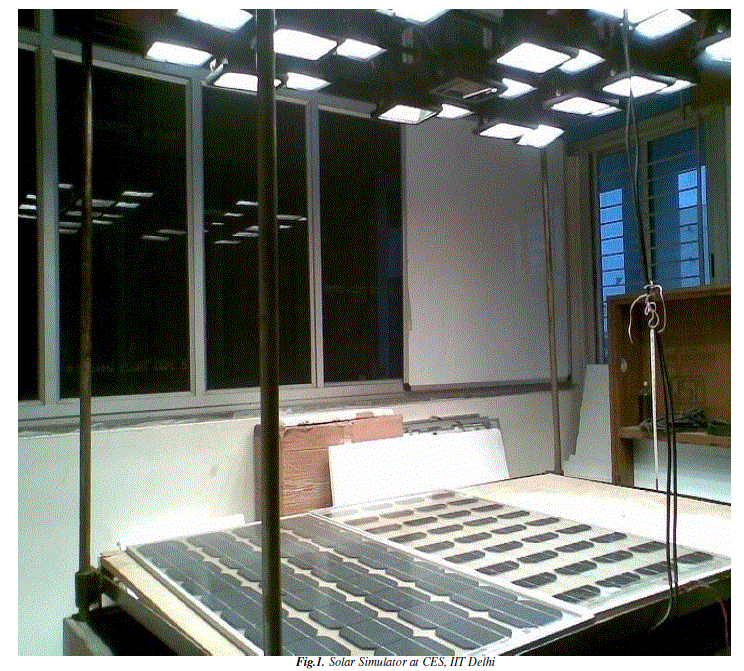 |
| B. Parameters to be measured |
| The following parameters are to be measured during the Experimentation |
| Photovoltaic (PV) Module temperature (ºC). |
| Intensity (W/m2). |
| Load current, IL (Amp.) and load voltage, VL (Volt). |
| Short circuit current, ISC (Amp.) and open circuit voltage VOC (Volt). |
| C. Parameters to be calculated |
| The following parameters are to be calculated after the Experimentation |
| DC Power output by the modules. |
| Efficiency of PV Modules. |
| Temperature coefficient of efficiency (TCE). |
| D. Observations |
| The Opaque PV Module (A 0283) is tested under a simulator with intensity 480 W/m2. At this intensity, the module is first
tested under short circuit condition. For short circuit condition, voltage measured is zero and the current measured is 1.3
Amp. Afterwards voltage and current of module are measured at open circuit condition. For open circuit, current measured
is zero and voltage measured is 19.1 volt. After testing the module under open circuit and short circuit conditions, the
current and voltage of module under variable load condition is measured by rheostat as shown in the table 1.The DC power
obtained from the module is calculated by multiplying the voltage and the current. The power output is zero at both the
open circuit and short circuit conditions but it has a significant value under varying load condition. For the varying load, the
power first increases until it reaches a peak value. After the peak, it starts decreasing and finally becomes zero. These
results are shown in table (1).The variation of current with voltage and dc power with voltage is shown in Fig 2.
Module Efficiency is calculated by using eq.(1) |
 (1) (1) |
| It comes out 0.092. |
| Now the temperature coefficient of efficiency (TCE) of module is calculated, using the eq. (2): |
 (2) (2) |
| By this formula, we can get final expression for temperature coefficient of efficiency (TCE) of module (β) , given in eq. (3): |
 (3) (3) |
| Where n0 and are the electrical efficiency of module (0.12) and ambient temperature (25 ºC) at standard test condition
respectively. |
| The temperature coefficient of efficiency (TCE) of module ( at average intensity of 480 W/m2 is calculated by eq. (3) and
it comes out 0.0057 (/ºC).
The Opaque photovoltaic (PV) Module (A 0283) is now tested under the simulator with average intensity 569 W/m2, 640
W/m2 and 746 W/m2. At these intensities, the module is first tested under short circuit condition. Afterwards voltage and
current of module are measured at open circuit condition. After testing the module under open circuit and short circuit
conditions, the current and voltage of module under variable load condition is measured by rheostat. The DC power
obtained from the module is calculated by multiplying the voltage and the current. The results are shown in table (2), (3),
(4) and the variation of current with voltage and dc power with voltage is shown in Fig. (3), (4), (5) for average intensity
569 W/m2, 640 W/m2 and 746 W/m2 respectively.
Module Efficiency at these variable intensity condition is calculated by using eq. (1). Also the temperature coefficient of
efficiency (TCE) of module ( is calculated by eq. (2) |
| Average Intensity, Ī (t) = 480 W/m2 |
| Average Module Temperature, T = 66 ºC |
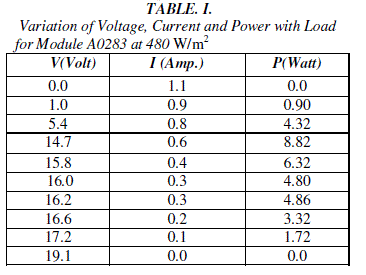 |
| Average Intensity, Ī (t) = 569 W/m2. |
| Average Module Temperature, T = 68 ºC |
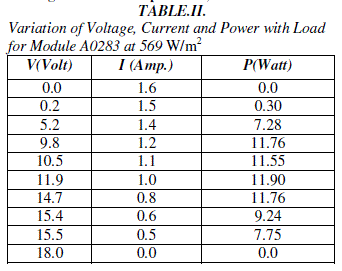 |
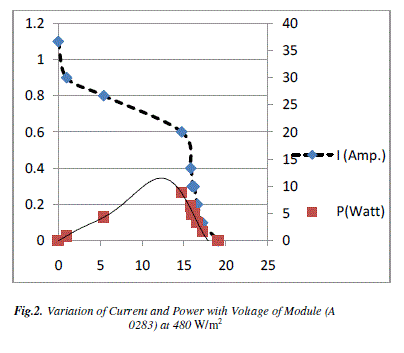 |
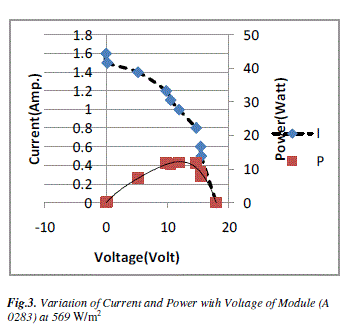 |
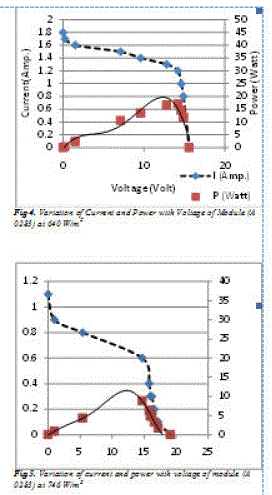 |
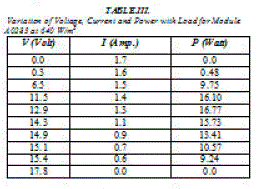 |
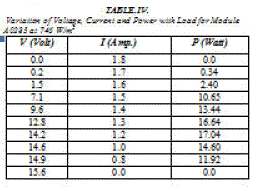 |
DISCUSSION |
| A. Effects of temperature variation on electrical efficiency of module and calculation of temperature coefficient of
efficiency (TCE) |
 |
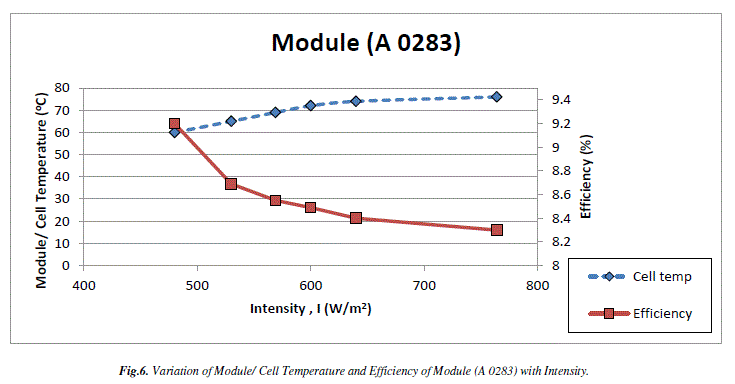 |
| For Opaque photovoltaic (PV) Module (A 0283), variation of module temperature, percentage efficiency and Temperature
coefficient of Efficiency (TCE) with intensity is given in table (5). From Fig. (6), it is clear that with the increase of
intensity, module temperature increases but the rate of increase of module temperature decreases. On the other hand,
efficiency of module decrease with the increase of intensity because when module temperature increases, the saturation
current also increases with intrinsic carrier concentration so the open circuit voltage of module reduces and the short circuit
current of module increases. But the effect of increasing module temperature on short circuit current is small than open
circuit voltage so the overall effect of increased module temperature is a reduction in output power of module hence the
efficiency of module reduces. |
| It is also observed that with increase in solar intensity, if the module temperature becomes very high as compare to
temperature at standard test condition (250C) then efficiency of module only reduces even with increase in solar intensity.
B. Effect of ‘Temperature Coefficient of Efficiency (TCE) at increased temperature’ on ‘electrical efficiency’ of
opaque type photovoltaic (PV) module |
 |
| The comparison of electrical efficiency of module for Temperature Coefficient of Efficiency (TCE) at standard test
condition (β=0.0045 ) and at its calculated value for increased temperature is shown in table (6). |
| If we compare the results then it is observed that the electrical efficiency of module at ‘temperature coefficient of efficiency
(TCE) for increased temperature’ is always less than the electrical efficiency of module at ‘temperature coefficient of
efficiency (TCE) for standard test condition’. So it is clear that the Temperature Coefficient of Efficiency (TCE) is not
constant but it increases with temperature increment and hence reduces the electrical efficiency of module. |
ACKNOWLEDGEMENT |
| I thank to my supervisor of post graduation (M.Tech) Project, Prof. G.N. Tiwari, Centre for Energy Studies, Indian Institute
of Technology (IIT) Delhi, for his active cooperation at various stages of the work. |
References |
- Kaldellis, J.K., Zafirakis, D., âÃâ¬ÃÅKondili, E., Energy pay-back period analysis of stand-alone photovoltaic systemsâÃâ¬ÃÂ, Renewable Energy 35, 1444âÃâ¬Ãâ 1454, 2010.
- Kato, K., Murata, A., Sakuta, K., âÃâ¬ÃÂEnergy payback time and Life cycle CO2 emission of residential PV power system with silicon PV moduleâÃâ¬ÃÂ, Progress in Photovoltaic: Research and Applcations 6, 105-115, 1998.
- Mazer, JA., âÃâ¬ÃÂSolar cells: an introduction to crystalline photovoltaic technologyâÃâ¬ÃÂ, Kluwer Academic Publications., 108, 1997.
- Meyer, EL., Van Dyk, EE.,âÃâ¬ÃÂDegradation analysis of silicon photovoltaic modulesâÃâ¬ÃÂ, Proceedings of 16th European PV solar energy conference, 2272âÃâ¬Ãâ5, 2000.
- Tiwari, A., Barnwal, P., Sandhu, G.S., Sodha, M.S., âÃâ¬ÃÅEnergy metrics analysis of hybrid Photovoltaic (PV) modulesâÃâ¬ÃÂ, Applied Energy 86, 2615âÃâ¬Ãâ 2625. 2009
- Tiwari, G.N., Mishra, R.K., Solanki, S.C., âÃâ¬ÃÅPhotovoltaic modules and their applications: A review on thermal modelingâÃâ¬ÃÂ, Applied Energy 88, 2287âÃâ¬Ãâ2304. 2011
- Van Dyk, EE., Scott, BJ., Meyer, EL., Leitch, AWR., âÃâ¬ÃÅTemperature dependence of performance of crystalline silicon modulesâÃâ¬ÃÂ. S Afr J Sci 96, 198âÃâ¬Ãâ200. 2000.
|